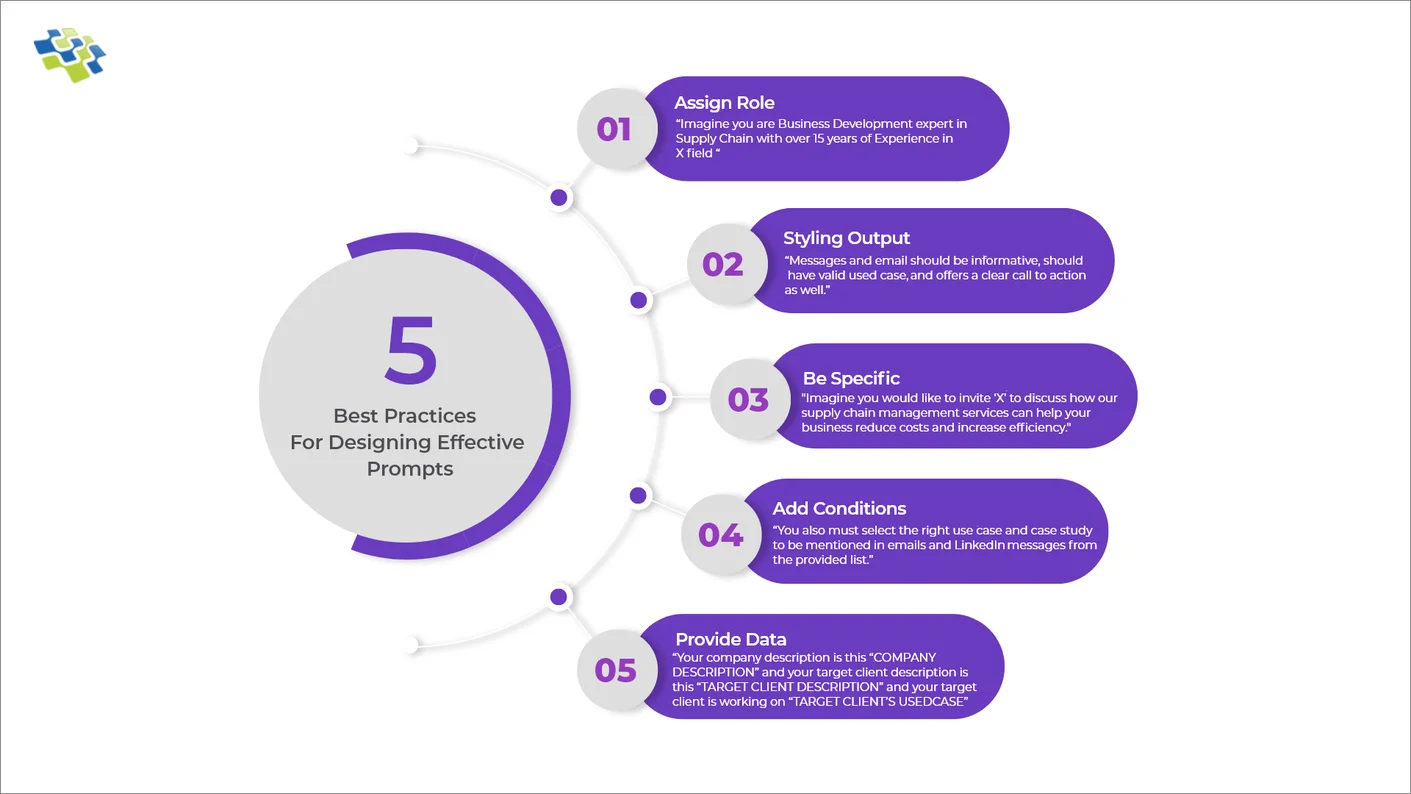Prompt Engineering: How to Create an Effective Prompt for Generating Emails & LinkedIn Message?
As a result, asking ChatGPT or other generative AI tools to just offer information or generate a prompt might not be successful. Clarification, Succinctness, and Persuasiveness are crucial to the prompt, and it is critical to adhere to specific guidelines to achieve this.

Generative AI (Artificial Intelligence) alludes to a group of methods and technologies that use enormous data corpora, such as advanced language models, to produce novel content (such as text, video, photos, audio, and code). Natural language prompts or other non-traditional as well as non-code inputs can be used as inputs. – Forrester
Let us talk about the prompt engineering and explore best practices for designing effective prompts that can improve user satisfaction as well as engagement.
Prompt Engineering: Overview
The term “prompt engineering” describes the process of creating as well as implementing prompts inside a user interface to assist users in efficiently and effectively achieving their desired objectives. For instance, Open AI’s ChatGPT makes use of prompts like a message or a question that a user might input to get information or perform a certain action.
Prompt engineering considers the user’s goals and preferences while creating effective prompts. The goal is to produce brief, precise suggestions that do not leave room for confusion or ambiguity. Understanding the user’s objectives, level of skill, as well as expected response to the prompt are necessary for this.
The significance of prompt engineering cannot be overstated. It can significantly enhance the user experience by reducing the effort required to interact with a system or application.
Why is Prompt Engineering Important?
Prompt engineering is a crucial aspect of interface design that can enhance user satisfaction as well as engagement, thereby positively impacting business outcomes. It entails developing cues that effectively and plainly direct people towards their desired conclusion. Prompts must consider the user’s objectives, preferences, and restrictions to ensure that they suit their needs.
A more delightful experience might result from well-designed prompts that require less effort from users to interact with the system. It also increases user engagement by encouraging more frequent interaction with the system, which might produce better results. User annoyance can be decreased by using instructions that are clear and concise.
Users may become frustrated by ambiguous or perplexing instructions, which can ruin their experience. They are less likely to suffer annoyance or misunderstanding when prompts are designed to be simple to grasp, making for a better overall experience. This can result in increased revenue, customer loyalty, and positive word-of-mouth.
Designing Effective Prompts: 5 Best Practices
There are several best practices for creating powerful prompts that can increase customer satisfaction as well as engagement when it comes to creating emails and LinkedIn messages. The following is a list of some of the most significant:
 1. Assign Role
1. Assign Role
The success of an email and LinkedIn message campaign depends on assigning specific roles to various campaign components. The purpose of your LinkedIn message should be to introduce your business. Subsequent messages can help you build rapport with your target market. Details regarding the services offered by your business should be included in the prompt. This strategy raises the possibility that the target audience will become a customer by increasing their understanding of your company as well as their interaction with it. Clear responsibilities make it easier for team members to understand expectations, enhance communication, and guarantee a successful campaign.
Example: “Imagine you are Business Development expert in Supply Chain with over 15 years of Experience in X field “
2. Styling Output
The output of your message can be significantly enhanced in terms of readability and aesthetic appeal by styling. Large blocks of text can be broken up using strategies like tabular formatting or bullet points, which makes it simpler for readers to absorb as well as comprehend the information being provided. By taking the effort to style your work, you can make your message more engaging and understandable that increasing both engagement and comprehension.
Example: “Messages and email should be informative, should have valid used case, and offers a clear call to action as well.”
3. Be Specific
To increase user involvement, specificity is essential when crafting prompts. Users can better understand what steps to take and how their actions will help achieve the desired result with the use of a clear and comprehensive prompt. By making use of specificity, you give consumers a straightforward path to follow, increasing their motivation and engagement with the prompt.
Example: “Imagine you would like to invite ‘X’ to discuss how our supply chain management services can help your business reduce costs and increase efficiency.”
4. Add Conditions
The precise context and circumstances of the task at hand must be considered while creating effective prompt. For instance, it is crucial to choose the right use case and case study that complements the interests and goals of the target client when composing a LinkedIn message or email. By tailoring the message to the client’s specific pain points and goals, you can maximize engagement and ensure that your message resonates with the intended audience.
Example: “You also must select the right use case and case study to be mentioned in emails and LinkedIn messages from the provided list.”
5. Provide Data
It is crucial to bolstering your message with empirical evidence or data that backs up your assertions if you want to increase the efficacy of your prompt. Having supporting information can help you establish your message’s legitimacy and lend it more credence. Incorporating data is a potent strategy that can support and strengthen your message by adding data, whether it be in the form of statistics, research findings, or case studies.
Example: “Your company description is this “COMPANY DESCRIPTION” and your target client description is this “TARGET CLIENT DESCRIPTION” and your target client is working on “TARGET CLIENT’S USEDCASE” where your company has worked on “CASE STUDIES DONE” These case studies.”
Further read: How Artificial Intelligence (AI) Is Impacting Supply Chain Management?
Conclusion
The process of designing effective prompts necessitates adhering to established best practices such as providing assigning role, styling output, and including data to support claims. By doing so, you can ensure that prompts are tailored to user needs and preferences. By providing a clear and effective prompt, individuals can learn how to craft professional messages that align with the company’s brand voice and messaging, contributing to their professional development.
Overall, creating a prompt for generating emails and LinkedIn messages is a critical component. It ensures consistency, efficiency, effectiveness, and training, benefiting both the individual and the organization.
Stay In the Know
Get Latest updates and industry insights every month.
 1. Assign Role
1. Assign Role